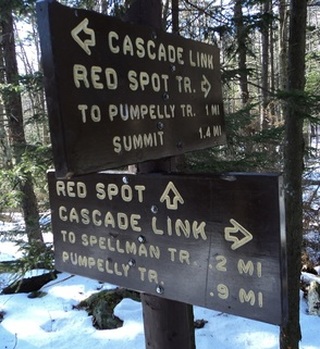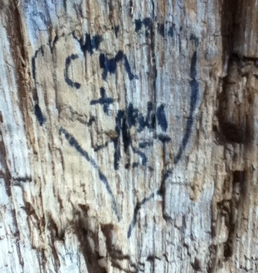
On the frigid peak enshrouded in racing, white cloud, the mountain zipped up in a coat of furry rime-ice, I meet a man wearing a Scottish kilt. It’s a green-and-gold tartan number, over blue jeans. Today is his 60th birthday and in celebration I give him a Nutter Butter cookie made, says the box, with real peanut butter. Oh thank you, he pipes, as if it’s the final piece in life’s confounding puzzle. We stamp our feet and munch our cookies down.
Let’s go back five hours. I’m leaving my house in Somerville, 12 feet above sea level, and I step off the front walk onto an ice-slick flagstone – whoosh, yikes, my limbs go spastic. Somehow, I recover before falling. At least I didn’t snap or tear anything. So I get in the car, not realizing that I’ve forgotten my camera, and my wife comes out to wave me away, as is our custom; whoever leaves first in the morning gets a big porch wave from the remaining spouse, regardless of the weather outside or inside the house. Today she wears her supportive, worried expression.
Let’s go back five hours. I’m leaving my house in Somerville, 12 feet above sea level, and I step off the front walk onto an ice-slick flagstone – whoosh, yikes, my limbs go spastic. Somehow, I recover before falling. At least I didn’t snap or tear anything. So I get in the car, not realizing that I’ve forgotten my camera, and my wife comes out to wave me away, as is our custom; whoever leaves first in the morning gets a big porch wave from the remaining spouse, regardless of the weather outside or inside the house. Today she wears her supportive, worried expression.

Halfway to New Hampshire, the oldies station gives me Stephen Stills warbling, “Stop, hey, what’s that sound, everybody look what’s going down,” and while I can’t remember the name of the song (For What It’s Worth) or the group (Buffalo Springfield), I do recall Stills’ solo concert at Boston College when I was a student there in 1981. He came on stage drunk or high and stumbled around playing incoherent guitar and mumbling lyrics. Alas, no Crosby, Nash, or Young provided harmony, no Wooden Ships sailed across the Roberts Center gym that’s since been demolished for a science building. He seemed old and broken-down at age 36. (Now at age 60, he’s sober and still touring.)
Today my weather app calls for sun, but everything’s socked in. Mount Monadnock hides in grayish clouds with a yellow, sulfurous tinge from wood stoves cranking since dawn. Six cars dot the parking lot. By 10:40 I’m geared up and going up, too.
The ice on the trail is thicker than last month, a translucent seal. Underfoot, black boulders appear like surfacing turtles, like sea monsters frozen in mid-escape. When I stop to rest and hydrate at the Cascade Link turnoff, a young woman skitters by. She's stripped down to a sleeveless t-shirt; I’m wearing three layers plus coat, wool hat and fleece gloves over a new pair of runner’s gloves with metal-fiber fingertips for fine-motor activities like tapping cell phone buttons or unwrapping the short sleeve of Nutter Butters in my pack. I wave to her, unzip my coat a bit.
With a temperature of 33 degrees at the base, and no storms forecast, this won’t be a day for perishing on the mountain. Only one hiker has died of hypothermia here, according to Monadnock: More than a Mountain. That poor soul was Charles MacVeagh, Jr., a 23-year old Harvard College graduate whose family owned a house in nearby Dublin. MacVeagh had climbed Monadnock hundreds of times, and so there was nothing unusual on the afternoon of Valentine’s Day, 1920, when he and friend Charlton Reynders took the Dublin Trail toward the peak. The sky was sunny and blue-jay blue, in the 50s, so they left behind their fur-lined coats and gloves. Just a February lark and back for supper! Then a freak blizzard arose and a tragic series of events followed. Poor Reynders saved himself by firing his revolver into the air, attracting the attention of Frederick Nettleton, the caretaker of the MacVeagh house, who had set out after dark to find them.
Today my weather app calls for sun, but everything’s socked in. Mount Monadnock hides in grayish clouds with a yellow, sulfurous tinge from wood stoves cranking since dawn. Six cars dot the parking lot. By 10:40 I’m geared up and going up, too.
The ice on the trail is thicker than last month, a translucent seal. Underfoot, black boulders appear like surfacing turtles, like sea monsters frozen in mid-escape. When I stop to rest and hydrate at the Cascade Link turnoff, a young woman skitters by. She's stripped down to a sleeveless t-shirt; I’m wearing three layers plus coat, wool hat and fleece gloves over a new pair of runner’s gloves with metal-fiber fingertips for fine-motor activities like tapping cell phone buttons or unwrapping the short sleeve of Nutter Butters in my pack. I wave to her, unzip my coat a bit.
With a temperature of 33 degrees at the base, and no storms forecast, this won’t be a day for perishing on the mountain. Only one hiker has died of hypothermia here, according to Monadnock: More than a Mountain. That poor soul was Charles MacVeagh, Jr., a 23-year old Harvard College graduate whose family owned a house in nearby Dublin. MacVeagh had climbed Monadnock hundreds of times, and so there was nothing unusual on the afternoon of Valentine’s Day, 1920, when he and friend Charlton Reynders took the Dublin Trail toward the peak. The sky was sunny and blue-jay blue, in the 50s, so they left behind their fur-lined coats and gloves. Just a February lark and back for supper! Then a freak blizzard arose and a tragic series of events followed. Poor Reynders saved himself by firing his revolver into the air, attracting the attention of Frederick Nettleton, the caretaker of the MacVeagh house, who had set out after dark to find them.

On a flat shelf I stop to chat with three hikers. A black lab named Layla shutters about them, wearing an REI doggie backpack filled with water. (Dogs are barred from Monadnock year round.) Layla’s curved toenails are a couple inches long, perhaps explaining how she traversed the icy climb. Cammie tells me that Layla stays to the trail, and if a dastardly rabbit or chipmunk lures her away all it takes is a blow on the “panic whistle” and she’s back like a shot. A short woman in her forties, Cammie says nothing else during my brief visit; she does, however, roll her eyes a few times as her companions expound.
Art and Pete, in their early 60s, are youngish codgers. “So how’s Somerville,” Art asks, “pretty posh?” Posh? Somerville, once dubbed Slumerville and Scumerville, is emerging from its rusty chain-link fence past and enjoys media hype for its high hipster quotient, but posh? No, my town ain’t posh. Arts claims that in the ‘70s he rented a house in Davis Square for 200 bucks a month, those were the days, and Pete kvetches that he led a hike for the Appalachian Mountain Club (AMC) recently and two kids in their 20s turned back “because they were tired.” He pauses, lets the outrage penetrate, repeats: “BECAUSE THEY WERE TIRED!” Kids today have it backwards, says Art, they work too hard and don't recreate enough, but Pete isn't seeing things that way, tells the tale of an intern at his company who skipped work because he felt like playing the piano – “FELT LIKE PLAYING THE PIANO!" – and then it’s time to bash the AMC because it’s gone all soft and cushy.
“Run by lawyers,” says Art, or maybe Pete, run by lawyers despoiling all that is fine and good on G-d’s green planet, those kind of lawyers, and they both agree that the high-mountain huts for the Adirondock (not Appalachian) Mountain Club are superior with their lack of heat, food, hut crews or creature comforts. (Here Cammie’s eyes spin from her skull and attain a low-earth orbit.) I defend the AMC, where I worked in the 1990s, and Art allows that the AMC hut crews, mostly college students, do put on funny skits for hikers.
To this, we all agree. The stupid kids put on funny skits.
Meanwhile, Layla laps water from her collapsible water dish and Pete pours me a cup of hot chocolate from a steel thermos. It’s steaming and delicious. “The real stuff,” Pete purrs. So where’s the sun? I ask. It’s supposed to be sunny. Well, says Pete, for weather done right you gotta call the FAA (Federal Aviation Administration). All you need is a tail number. (Of course, a tail number). The FAA nailed it today, Pete continues, total cloud cover, wind whipping from the west. Sun should peek out by afternoon, adds Art, and we discuss, too, the song Layla. You know, Layla, you’ve got me on my knees, Layla, I’m begging darling, please, and by consensus the tune is performed by Eric Clapton with Derick and the Dominoes, not Eric Clapton with Cream.
As I gather to leave, I ask: are you going to the top? No, says Art, not today. Above the tree line in winter, he explains, the “fun factor is diminished.” I try to disguise my shock. “ABOVE THE TREE LINE THE FUN FACTOR IS DIMINISHED!” What I say aloud is thanks for the cocoa, good luck, and bye-bye, Layla.
Art and Pete, in their early 60s, are youngish codgers. “So how’s Somerville,” Art asks, “pretty posh?” Posh? Somerville, once dubbed Slumerville and Scumerville, is emerging from its rusty chain-link fence past and enjoys media hype for its high hipster quotient, but posh? No, my town ain’t posh. Arts claims that in the ‘70s he rented a house in Davis Square for 200 bucks a month, those were the days, and Pete kvetches that he led a hike for the Appalachian Mountain Club (AMC) recently and two kids in their 20s turned back “because they were tired.” He pauses, lets the outrage penetrate, repeats: “BECAUSE THEY WERE TIRED!” Kids today have it backwards, says Art, they work too hard and don't recreate enough, but Pete isn't seeing things that way, tells the tale of an intern at his company who skipped work because he felt like playing the piano – “FELT LIKE PLAYING THE PIANO!" – and then it’s time to bash the AMC because it’s gone all soft and cushy.
“Run by lawyers,” says Art, or maybe Pete, run by lawyers despoiling all that is fine and good on G-d’s green planet, those kind of lawyers, and they both agree that the high-mountain huts for the Adirondock (not Appalachian) Mountain Club are superior with their lack of heat, food, hut crews or creature comforts. (Here Cammie’s eyes spin from her skull and attain a low-earth orbit.) I defend the AMC, where I worked in the 1990s, and Art allows that the AMC hut crews, mostly college students, do put on funny skits for hikers.
To this, we all agree. The stupid kids put on funny skits.
Meanwhile, Layla laps water from her collapsible water dish and Pete pours me a cup of hot chocolate from a steel thermos. It’s steaming and delicious. “The real stuff,” Pete purrs. So where’s the sun? I ask. It’s supposed to be sunny. Well, says Pete, for weather done right you gotta call the FAA (Federal Aviation Administration). All you need is a tail number. (Of course, a tail number). The FAA nailed it today, Pete continues, total cloud cover, wind whipping from the west. Sun should peek out by afternoon, adds Art, and we discuss, too, the song Layla. You know, Layla, you’ve got me on my knees, Layla, I’m begging darling, please, and by consensus the tune is performed by Eric Clapton with Derick and the Dominoes, not Eric Clapton with Cream.
As I gather to leave, I ask: are you going to the top? No, says Art, not today. Above the tree line in winter, he explains, the “fun factor is diminished.” I try to disguise my shock. “ABOVE THE TREE LINE THE FUN FACTOR IS DIMINISHED!” What I say aloud is thanks for the cocoa, good luck, and bye-bye, Layla.

The higher I go, the thicker the cloud; nothing is visible up, down or along the curve of the earth beyond 20 or so feet. It’s as if I’m climbing into a vast whiteness, the way marked by rock cairns and decorated with snow-encrusted evergreen trees. There’s a bit of the Fairyland up here, and I half expect a snow elf to pop from a drift. The painted marks for the Red Spot Trail – a red dot swimming in white, like a bloodshot eye – are visible beneath the ice on rock surfaces. Large boulders are covered in rime ice, formed from the freezing water droplets of fog. The rime ice looks like fur, bent with the wind. Up close it resembles tiny, white seedlings struggling from rock. I run my hand across the rime and it won’t budge.
Above the tree line, the wind gusts harder. Snow swirls in a mad rush to get nowhere. It’s white and wild up here. With a certain mad glee, permit me to state that above the tree line the fun factor skyrockets. As long as you know, of course, that you can come back down.
At the summit, I tap the ice cap over the mountain’s geodetic benchmark and check my watch: two and a half hours up. And that’s when I spy the birthday-boy Scotsman in his tartan best. I wish I’d asked him about the clan colors of his skirt and if he climbs Monadnock every year on his birthday, but we were too busy freezing our asses and scarfing Nutter Butters. I do learn that he came up the Old Halfway House Trail. The Halfway House, an inn on the southwestern side of Mount Monadnock, operated for almost 100 years until it burned down in 1954. Trees have since reclaimed the site entirely.
Now the Scotsman produces his phone to call his wife, and I move to another rime-iced rock to give him space. As I stare into nothing but cloud to the west, and then nothing but cloud to the north, I hear my summit friend describe the mountain as “Arctic” and “treacherous.”
Sure, it’s bitter cold and crazy windy, but that’s laying it on a bit thick. Or is it Arctic and treacherous up here? Have I lost perspective in extremity? If I were but a few pounds lighter, might a rogue wind rip me kite-like into thin air and send my body soaring off the majestic mountain…just then a young man arrives in Lycra tights, windbreaker and trail-running boots with MICROspikes. He’s ultrathin, ultralight, bounding like an ibex. No poles, they’re for old guys. He taps the benchmark with his foot, as I do, but then immediately heads back down the mountain. Down into white he goes. I listen. No foot falls. He’s gone.
What in the world? He didn’t even pause, say hello, or eat a cookie. Didn’t stand at the tip of a rock in a cloud. Didn’t take in the glorious immensity. Not for one second did the runner become a guest of the mountain. Go figure. Kids today. And now I’m one step closer to joining Art and Pete in the Royal Fraternity of Grousing Codgers, Northeast Division.
Above the tree line, the wind gusts harder. Snow swirls in a mad rush to get nowhere. It’s white and wild up here. With a certain mad glee, permit me to state that above the tree line the fun factor skyrockets. As long as you know, of course, that you can come back down.
At the summit, I tap the ice cap over the mountain’s geodetic benchmark and check my watch: two and a half hours up. And that’s when I spy the birthday-boy Scotsman in his tartan best. I wish I’d asked him about the clan colors of his skirt and if he climbs Monadnock every year on his birthday, but we were too busy freezing our asses and scarfing Nutter Butters. I do learn that he came up the Old Halfway House Trail. The Halfway House, an inn on the southwestern side of Mount Monadnock, operated for almost 100 years until it burned down in 1954. Trees have since reclaimed the site entirely.
Now the Scotsman produces his phone to call his wife, and I move to another rime-iced rock to give him space. As I stare into nothing but cloud to the west, and then nothing but cloud to the north, I hear my summit friend describe the mountain as “Arctic” and “treacherous.”
Sure, it’s bitter cold and crazy windy, but that’s laying it on a bit thick. Or is it Arctic and treacherous up here? Have I lost perspective in extremity? If I were but a few pounds lighter, might a rogue wind rip me kite-like into thin air and send my body soaring off the majestic mountain…just then a young man arrives in Lycra tights, windbreaker and trail-running boots with MICROspikes. He’s ultrathin, ultralight, bounding like an ibex. No poles, they’re for old guys. He taps the benchmark with his foot, as I do, but then immediately heads back down the mountain. Down into white he goes. I listen. No foot falls. He’s gone.
What in the world? He didn’t even pause, say hello, or eat a cookie. Didn’t stand at the tip of a rock in a cloud. Didn’t take in the glorious immensity. Not for one second did the runner become a guest of the mountain. Go figure. Kids today. And now I’m one step closer to joining Art and Pete in the Royal Fraternity of Grousing Codgers, Northeast Division.

On my way down, I let six slipping and sliding teenage boys pass on their way to the peak. One doesn’t wear a hat. None has poles or spikes. But they keep going, legs loose and forgiving, hearts cheerful. You’re almost there, I exhort them, and the blond, hatless boy smiles. Youth overcomes, although I’m sure Charles MacVeagh and Charlton Reynders thought they were invincible on that Valentine’s Day in 1920. At the tree line: the sun! A sun-sliver, to be more exact, appears all around as if a cloud bowl has been lifted a few inches off the mountain. The ring of sun shimmers with touches of pink and blue.
Twenty minutes from the bottom, I stop at a tall, grizzled oak tree with a split running up its trunk, either from age or, I prefer, lightning strike. The trunk is hollow at the bottom and I duck inside. On the interior walls messages are scrawled with black ink, including “I Was Here – Chloe” and the cryptic “MQ14.” BP and SF live forevermore inside a ragged heart, and within another heart the initials joined to CM have been savagely crossed-out and replaced with ST. In pulling myself from the hollow, I bump my head on the tree’s gnarled, blackened burl. For a moment, I’m dizzy. I check with a finger – no blood, at least.
At the parking area, a sign commemorates the Civilian Conservation Corps. It reads: “Work crews from the Civilian Conservation Corps helped with the development of this park during the period 1933-1942.” That’s what kids need today, my inner codger cogitates, a new CCC, and I flash to my mother’s story about staying with her aunt in northern Vermont. She was a teenager and the highlight of the day was picking blueberries down by the state road and waving to the boys in the back of the CCC truck as it rumbled by. She’d comb her hair, put on a nice blouse for the occasion. Those boys, she recalls, standing up in the trunk. Some of them probably died in the war, you know.
My phone’s dead, so there’s no calling Elahna to let her know I’m okay. I also discover that it’s hard to untie shoelaces when they’re ice-coated, frozen ropes. Oy, I’m pretty hopeless; maybe the young people should take over. Anyway, it’s happening whether we old folks grouse or cheer them along. How did that Stephen Stills song go again? Stop, hey, what’s that sound, everybody look what’s going down…
Twenty minutes from the bottom, I stop at a tall, grizzled oak tree with a split running up its trunk, either from age or, I prefer, lightning strike. The trunk is hollow at the bottom and I duck inside. On the interior walls messages are scrawled with black ink, including “I Was Here – Chloe” and the cryptic “MQ14.” BP and SF live forevermore inside a ragged heart, and within another heart the initials joined to CM have been savagely crossed-out and replaced with ST. In pulling myself from the hollow, I bump my head on the tree’s gnarled, blackened burl. For a moment, I’m dizzy. I check with a finger – no blood, at least.
At the parking area, a sign commemorates the Civilian Conservation Corps. It reads: “Work crews from the Civilian Conservation Corps helped with the development of this park during the period 1933-1942.” That’s what kids need today, my inner codger cogitates, a new CCC, and I flash to my mother’s story about staying with her aunt in northern Vermont. She was a teenager and the highlight of the day was picking blueberries down by the state road and waving to the boys in the back of the CCC truck as it rumbled by. She’d comb her hair, put on a nice blouse for the occasion. Those boys, she recalls, standing up in the trunk. Some of them probably died in the war, you know.
My phone’s dead, so there’s no calling Elahna to let her know I’m okay. I also discover that it’s hard to untie shoelaces when they’re ice-coated, frozen ropes. Oy, I’m pretty hopeless; maybe the young people should take over. Anyway, it’s happening whether we old folks grouse or cheer them along. How did that Stephen Stills song go again? Stop, hey, what’s that sound, everybody look what’s going down…
 RSS Feed
RSS Feed